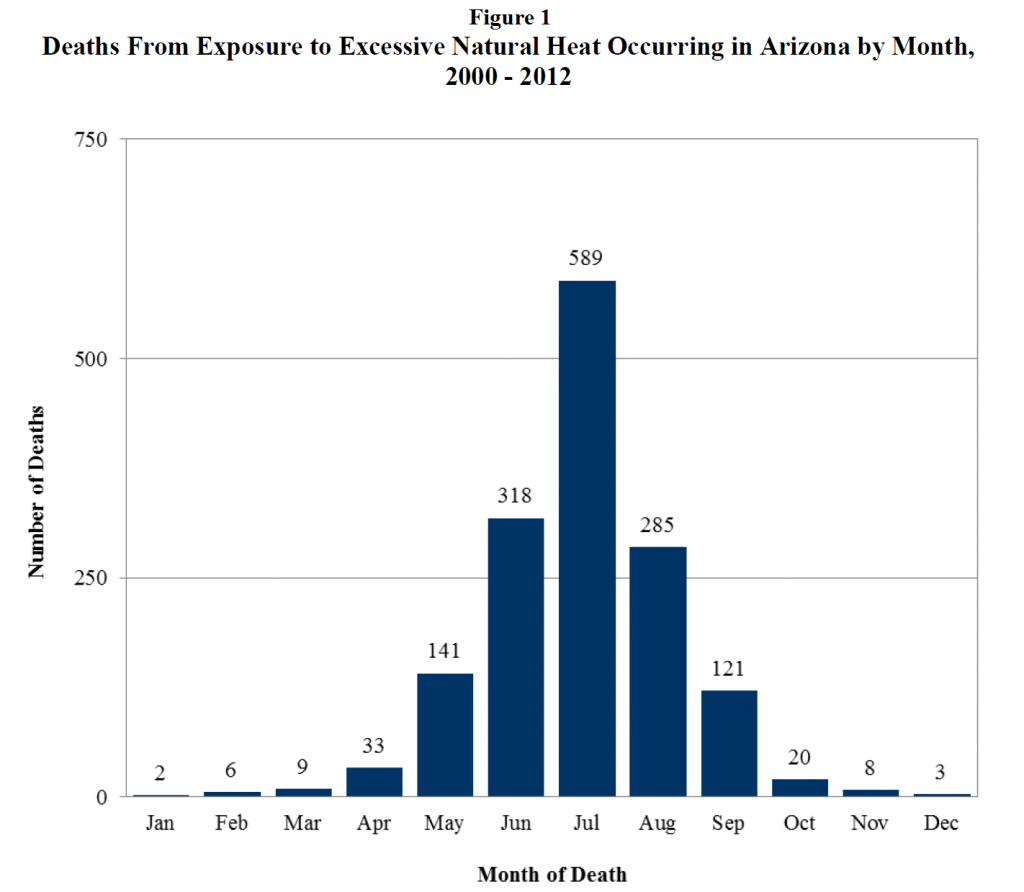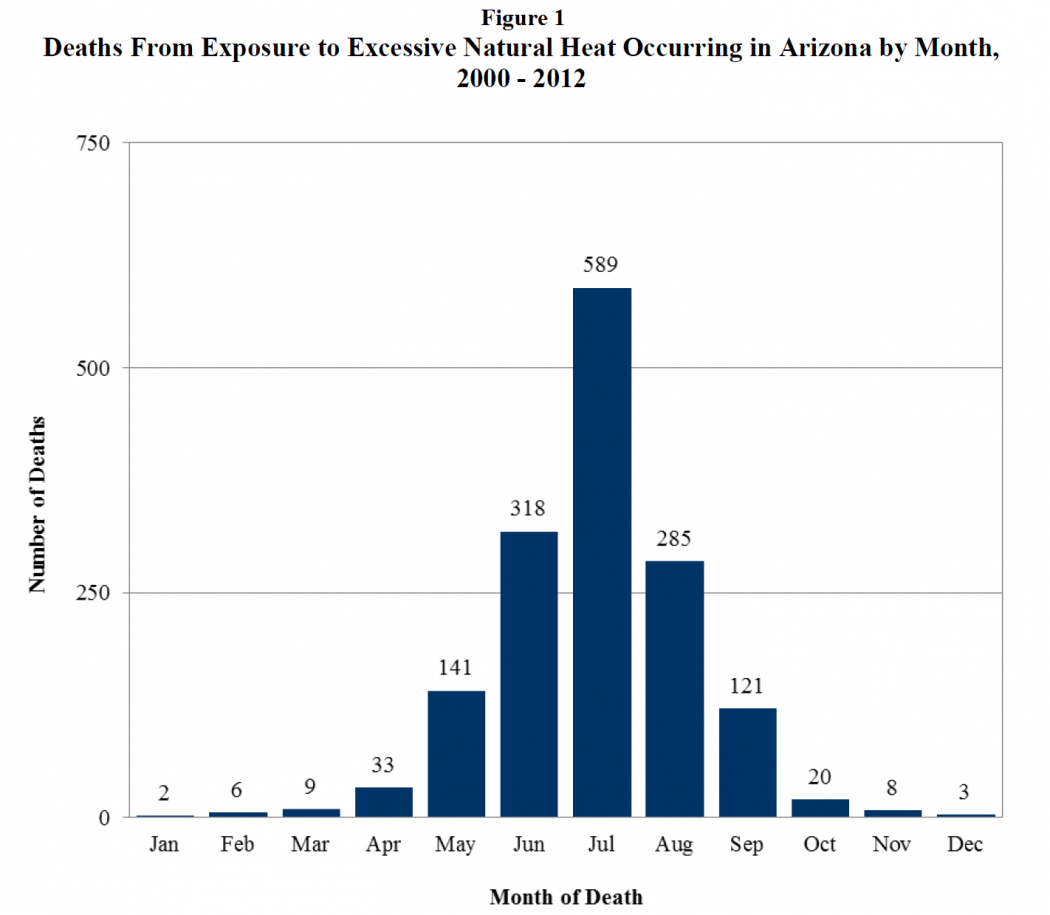Arizona has the fortune and misfortune of being a sunny state for a significant part of the year, and the hot season is just around the corner! While the relative warmth during the fall and winter makes many eastern states envious, the heat we receive from May to September is a non-trivial public health concern (Figure 1) [1].

Figure 1.
Heat-related illnesses such as heat cramps, heat exhaustion, heat syncope, or heat-stroke are serious possibilities for patients this summer. These illnesses result when the body becomes unable to effectively regulate temperature via balancing heat load with heat dissipation [3]. In the US during 1999 to 2003, extreme heat contributed either as a direct cause or contributing factor to 3442 deaths [2]. From 1979-2003, excessive heat exposure caused 8,015 deaths in nationwide—more deaths than from hurricanes, lightning, tornadoes, floods, and earthquakes combined. At the state level, Arizona, between 2000 and 2012, reported an average of 118 heat-related deaths annually [1].
Which patient demographics are at greatest risk and should be educated as such? Older adults (aged ≥65 years), individuals with chronic medical conditions (e.g., cardiovascular disease, respiratory conditions, diabetes, and obesity), individuals currently taking certain medications (diuretics, especially), outdoor workers, homeless individuals, athletes, and infants/young children [3]. Data from the Arizona Department of Public Health Services shows that between 2000 and 2012, the Hispanic/Latino population saw the most deaths (898), followed by White Non-Hispanic (444), American Indian/Alaskan Native (50), African American/Black (40), Asian/Pacific Islander (10), and Unknown (100). Geographically, Maricopa and Pima Counties have the highest absolute number of children under the age of 5, individuals ≥65 years of age, and individuals who live below the poverty line [4]. These are all contributing factors to risk of heat-related illnesses, and as would be expected, the number of deaths between 2000 and 2012 in Maricopa and Pima counties were 460 and 729, respectively (both the highest number of deaths of all counties in the state of Arizona).
What signs and symptoms indicate that an individual is suffering from extreme heat? First and foremost is thirst! By the time an individual feels thirsty, they are already mildly dehydrated. Second is heat cramps due to heavy water and salt loss; these are characterized by muscular pains/spasms, usually involving the abdominal muscles or legs. Thirdly, heat exhaustion—while less severe than heat stroke—results in paleness, heavy sweating, headache, nausea & vomiting, dizziness, and exhaustion. If heat exhaustion is left untreated, it may progress to the fourth and most serious and life-threatening heat-related illness: heat stroke. Heat stroke is characterized by red, hot, dry skin, confusion, rapid pulse, and a very high body temperature (above 103°F) [2].
What are the potential interventions and recommendations for both avoiding extreme heat and treating heat-related illnesses? The most pertinent instructions for patients are: drink water regularly (to compensate for losses of up to 4 liters of water hourly), avoid alcohol and caffeine (which dehydrate the body), avoid the use of salt tablets unless directed to do so by a physician, wear lightweight, light-colored clothing, avoid strenuous activity, and stay indoors when possible during the hottest hours of the day. For heat cramps or exhaustion, the primary objectives are to get the person to a cooler location, have the person rest, and attempt to give cool water (without letting them drink too quickly). Remember liquids that contain alcohol or caffeine can make conditions worse. Heat stroke is a life-threatening situation! Immediately call emergency medical services (9-1-1) and then attempt to cool the patient by any means available (including cool water and ice; do not use rubbing alcohol because it closes the skin’s pores and prevents heat loss).
While this piece does not provide advanced information on heat-related illness, it is hoped that the information provided has begun to educate the reader on this important issue. For certainly more information, one can visit the CDC website concerning extreme heat (http://www.bt.cdc.gov/disasters/extremeheat) or Arizona’s very own Department of Public Health Services page on extreme heat (http://www.azdhs.gov/phs/oeh/extreme/heat/).
References:
- Trends in Morbidity and Mortality from Exposure to Excessive Natural Heat in Arizona, 2012 report. The Bureau of Epidemiology & Disease Control, The Bureau of Public Health Statistics, Arizona Department of Health Services. http://www.azdhs.gov/plan/report/im/heat/trends-in-morbidity-and-mortality-from-exposure-to-excessive-natural-heat-in-az-2012.pdf. 2012. Accessed March 05, 2015.
- Emergency Preparedness and Response: Extreme Heat. Office of Public Health Preparedness and Response (OPHPR), Centers for Disease Control and Prevention (CDC) website. http://www.bt.cdc.gov/disasters/extremeheat/. Updated July 27, 2012. Accessed March 10, 2015.
- Surviving Arizona’s Extreme Heat. Maricopa County Department of Public Health website. http://www.maricopa.gov/publichealth/programs/heat/default.aspx. Accessed March 05, 2015.
- Extreme Weather and Public Health: Heat Safety. Arizona Department of Health Services website http://www.azdhs.gov/phs/oeh/extreme/heat/. Updated August 14, 2014. Accessed March 05, 2015.
Ralph Mohty is a dual degree MD/MPH student at the University of Arizona College of Medicine-Phoenix. He completed degrees in Mathematics and Physiology at the University of Arizona.


